U-Pb Detrital Zircon Ages and Geochemical Features of the Jingxing Formation, (Qamdo Basin, Tibet: Implications): Inferences for the Metallogenic Model of the East Tethys Evaporite
Abstract
:1. Introduction
2. Geological Setting
3. Materials and Methods
4. Results
4.1. Petrography
4.2. Whole Rock Geochemistry
4.3. U-Pb Geochronology
5. Discussion
5.1. Source Area Weathering and Sediment Recycling
5.2. Geochemical Provenance Signatures
5.3. Detrital Zircon Provenance
6. Implications for Late Cretaceous Potassium Mode in the Eastern Tethys
7. Conclusions
Supplementary Materials
Author Contributions
Funding
Data Availability Statement
Acknowledgments
Conflicts of Interest
References
- Pan, G.T.; Wang, L.Q.; Li, R.S. Tectonic model of archipelagic arc-basin systems: The key to the continental geology. Sediment. Geol. Tethyan Geol. 2012, 32, 1–20. [Google Scholar]
- Wu, F.Y.; Wan, B.; Zhao, L.; Xiao, W.J.; Zhu, R.X. Tethyan geodynamics. Acta Petrol. Sin. 2020, 36, 1627–1674. [Google Scholar]
- Wang, J.; Tan, F.W.; Wang, X.L.; Du, M.W.; Chen, M. The Sedimentary and Tectonic Characteristics of Qiangtang Basin in the Early Jurassic in Northern Xizang (Tibet). Acta Sedimentol. Sin. 2004, 22, 198–205. [Google Scholar]
- Wang, J.; Fu, X.G.; Li, Z.X.; Xiong, S. Formation and significance of the shales from North Qiangtang basin. Sediment. Geol. Tethyan Geol. 2010, 30, 11–17. [Google Scholar]
- Wang, J.; Fu, X.G.; Tan, F.W.; Chen, M.; He, J.L. A new sedimentary model for Qiangtang basin. Acta Sedimentol. Sin. 2010, 5, 884–893. [Google Scholar]
- Xia, G.Q.; Yi, H.S.; Huang, H.G.; Wu, X.F.; Hui, B. Meter-scale sedimentary cycles and genesis of Xiali Formation in Yanshiping area, Northern Tibet. J. Chengdu Univ. Technol. 2010, 37, 133–139. [Google Scholar]
- Su, T.N.; Zhang, W.Z.; Zhang, S.Z.; Zhang, H. Geologic features of gypsum strata in the middle part of Buqu Formation, Biluocuo area, Tibet. Jilin Geol. 2007, 26, 10–15. [Google Scholar]
- Li, Y.L.; Wang, C.S.; Li, T.N. Characteristics of the Jurassic saline deposits and its significance to hydrocarbon accumulation in Qiangtang basin of Tibet area. Acta Pet. Sin. 2008, 29, 17–178. [Google Scholar]
- Li, Z.X.; He, J.L.; Xiong, X.G.; Wu, T.; Bai, P.R. The upper Jurassic-Lower Cretaceous shenglihe oil shales and their formation in the Qiangtang basin, northern Xizang. J. Jilin Univ. Earth Sci. Ed. 2010, 40, 264–272. [Google Scholar]
- Wu, T.; Xiong, X.G.; Yi, C.X.; Bai, P.R.; He, Y.Z.; Liu, Z.C. Gypsolyte sedimentary environment of upper Jurassic-Lower Cretaceous in shenglihe area in northern Qiangtang basin. Xinjiang Pet. Geol. 2010, 31, 376–378. [Google Scholar]
- Zheng, M.P.; Yuan, H.R.; Zhang, Y.S.; Liu, X.F.; Chen, W.X.; Liu, J.S. Regional Distribution and Prospects of Potash in China. Acta Geol. Sin. 2010, 84, 1526–1553. [Google Scholar]
- Niu, X.S.; Chen, W.X.; Liu, X.F. Geochemial characteristics on salt springs and potash perspective in dogai coring area of Qiangtang basin. Geoscience 2013, 621–628. [Google Scholar]
- Qu, Y.H. Homology of potassium-bearing brine from Lanping-Simao basin and Khorat basin, Thailand. Geol. Chem. Miner. 1997, 19, 81–84. [Google Scholar]
- Yuan, Q.; Qin, Z.J.; Wei, H.C.; Sheng, S.R.; Shan, F.S. The Ore-forming Age and Palaeoenvironment of the Mengyejing Formation in Jiangcheng, Yunnan Province. Acta Geosci. Sin. 2013, 5, 631–635. [Google Scholar]
- Wang, L.C.; Liu, C.L.; Fei, M.M.; Shen, L.J.; Zhang, H.; Zhao, Y.J. First SHRIMP U-Pb zircon ages of the potash-bearing Mengyejing Formation, Simao Basin, southwestern Yunnan, China. Cretac. Res. 2015, 52, 238–250. [Google Scholar] [CrossRef]
- Xie, X.W. Report of Regional Geological Survey: Nangqian County, Qamdo County, Jiangda County; Tibet Institute of Geological Survey: Tibet, China, 2007; pp. 107–109. [Google Scholar]
- Wang, L.C.; Liu, C.L.; Gao, X.; Zhang, H. Provenance and paleogeography of the Late Cretaceous Mengyejing Formation, Simao Basin, southeastern Tibetan Plateau: Whole-rock geochemistry, U–Pb geochronology, and Hf isotopic constraints. Sediment. Geol. 2014, 304, 44–58. [Google Scholar] [CrossRef]
- Li, Y.S. Metallogenic Model of the Cretaceous Potassium-Bearing Evaporites Involving Changdu, Lanping-Simao and Khorat Basin. Ph.D. Thesis, University of Chinese Academy of Sciences, Beijing, China, 2015. [Google Scholar]
- Wang, L.C.; Liu, C.L.; Fei, M.X.; Shen, L.J.; Zhang, H. Sulfur isotopic composition of sulfate and its geological significance of the Yunlong formation in the Lanping basin, Yunnan Province. China Min. Mag. 2014, 23, 57–63. [Google Scholar]
- Gao, X.; Fang, Q.F.; Yao, W.; Peng, Q.; Dong, J.; Qin, H.; Di, Y.W. Genesis of the Mengyejing potash deposit in Lanping-Simao basin, Yunnan: Indication from the components of the ceposit. Acta Geosci. Sin. 2013, 34, 529–536. [Google Scholar]
- Hite, R.J.; Japakasetr, T. Potash deposits of the Khorat Plateau, Thailand and Laos. Econ. Geol. 1979, 74, 448–458. [Google Scholar] [CrossRef]
- Fedo, C.M.; Sircombe, K.N.; Rainbird, R.G. Detrital zircon analysis of the sedimentary record. Rev. Mineral. Geochem. 2003, 53, 277–303. [Google Scholar] [CrossRef]
- Gehrels, G. Detrital Zircon U–Pb Geochronology: Current Methods and New Opportunities; Wiley-Blackwell: Busby, Australia, 2012; pp. 47–62. [Google Scholar]
- Wu, F.Y.; Yang, J.H.; Wilde, S.A.; Liu, X.M.; Guo, J.H.; Zhai, M.G. Detrital zircon U–Pb and Hf isotopic constraints on the crustal evolution of North Korea. Precambrian Res. 2007, 159, 155–177. [Google Scholar] [CrossRef]
- Shen, C.B.; Mei, L.F.; Peng, L.; Chen, Y.Z.; Yang, Z.; Hong, G.F. LA-ICPMS U–Pb zircon age constraints on the provenance of Cretaceous sediments in the Yichang area of the Jianghan Basin, central China. Cretac. Res. 2012, 34, 172–183. [Google Scholar] [CrossRef]
- Bhatia, M.R. Plate tectonics and geochemical composition of sandstones. J. Geol. 1983, 91, 611–627. [Google Scholar] [CrossRef]
- Bhatia, M.R.; Crook, K.W. Trace element characteristics of graywackes and tectonic setting discrimination of sedimentary basins. Contrib. Mineral. Petrol. 1986, 92, 181–193. [Google Scholar] [CrossRef]
- Song, Y.C.; Hou, Z.Q.; Yang, T.N.; Zhang, H.R.; Yang, Z.S.; Tian, S.H.; Liu, Y.C.; Wang, X.H.; Liu, Y.X.; Xue, C.D.; et al. Sediment-Hosted Himalayan Base Metal Deposits in Sanjiang Region: Characteristics and Genetic Types. Acta Petrol. Mineral. 2011, 30, 355–380. [Google Scholar]
- Qin, X.W.; Ma, H.Z.; Zhang, X.Y.; Fan, Q.S.; Cheng, H.D.; Li, Y.S.; Miao, W.L.; Hai, Q.Y.; Shi, H.Y. Hydrochemical Characteristics of Salt Spring and Potassium-Prospecting in Changdu Ba-sin. J. Salt Lake Res. 2017, 25, 28–39. [Google Scholar]
- Wang, L.C.; Liu, C.L.; Shen, L.J.; Bo, Y. Research Advances in Potash Forming of the Simao Basin, Eastern Tethyan Realm. Acta Geol. Sin. 2018, 92, 1707–1723. [Google Scholar]
- Hou, Z.Q.; Lu, J.R.; Li, H.Y.; Wang, D.H.; Lu, Q.T. Tectonic evolution of the Tethys in southwestern China: Is controlled by plume tectonics. Acta Geosci. Sin. 1996, 17, 439–451. [Google Scholar]
- Miao, W.L. Sedimentary Characteristics and Source Links between Lanping-Simao and Khorat Basins, Based on the Analysis of Clastic Rocks of Salt-Bearing/Underlying Stratas; Implication for Regional Salt-Forming Setting. Ph.D. Thesis, University of Chinese Academy of Sciences, Beijing, China, 2016. [Google Scholar]
- Peng, Y.M.; Liu, J.Y. Triassic lithofacies and palaeogeography in Qamdo, east Tibet. J. Palaeogeoography 1994, 4, 26–34. [Google Scholar]
- Ye, H.F.; Luo, J.N.; Li, Y.T.; Tong, Z.Y.; Yu, Q.; Wang, X.L.; Zhu, T.X.; Feng, X.T. Tethyan tectonic domain and petroleum exploration. Sediment. Geol. Tethyan Geol. 2000, 01, 1–27. [Google Scholar]
- Luo, J.N.; Wang, X.L.; Li, Y.T.; Zhu, Z.F.; Feng, X.T.; Xie, Y. Sedimentary geological evolution of the Qinghai-Xizang Tethys. Sediment. Geol. Tethyan Geol. 2002, 1, 7–15. [Google Scholar]
- Yan, T.; Wu, G.Y.; Tang, M.Q. Tectono-sedimentary development of backarc continental basin in Yunnan, southern China. J. Southeast Asian Earth Sci. 1994, 9, 153–166. [Google Scholar] [CrossRef]
- He, L.Q. Tectonic seting and evolutionary pattern of Jinshajiang orogenic belt. Geoscience 1998, 12, 185–191. [Google Scholar]
- Ding, L.; Kapp, P.; Yue, Y.H. Postcollisional calc-alkaline lavas and xenoliths from the southern Qiangtang terrane, central Tibet. Earth Planet. Sci. Lett. 2007, 254, 28–38. [Google Scholar] [CrossRef]
- Zhang, K.J. Blueschist-bearing metamorphic core complexes in the Qiangtang block reveal deep crustal structure of northern Tibet: Comment and Reply. Geology 2001, 29, 91–95. [Google Scholar] [CrossRef]
- Tan, F.W.; Wang, G.M.; Hui, L. The relationship betwwen cenozioc tectonic regime and mineralization in eastern Tibet. Acta Geosci. Sin. 2001, 22, 123–128. [Google Scholar]
- Wang, Z.Z.; Tan, F.W.; Chen, M. Sedimentary-tectonic evolution and hydrocarbon potential in the Qamdo basin, eastern Xizang. Sediment. Geol. Tethyan Geol. 2018, 38, 85–96. [Google Scholar]
- Chen, H.H.; Wu, Y.; Xiao, Q.G.; He, S. Fluid Inclusion Evidence of Paleo-Oil Reservoirs in Changdu Basin, Tibet. Act Geol. Sin. 2010, 84, 1457–1469. [Google Scholar]
- Cullen, J.T.; Field, M.P.; Sherrell, R.M. Determination of trace elements in filtered suspended marine particulate material by sector field HR-ICP-MS. J. Anal. At. Spectrom. 2000, 16, 1307–1312. [Google Scholar] [CrossRef]
- Ludwig, K.R. User’s Manual for Isoplot 3.23: A Geochronological Toolkit for Microsoft Excel; Special Publication; Berkeley Geochronology Center: Berkeley, CA, USA, 2003; pp. 1–71. [Google Scholar]
- Hou, K.J.; Li, Y.H.; Tian, Y.R. In situ U–Pb zircon dating using laser ablation-multiion counting-ICP-MS. Miner. Depos. 2009, 28, 481–492. [Google Scholar]
- Taylor, S.R.; McClennan, S.R. The Continental Crust: Its Composition and Evolution; Blackwell Scientific Publication: Oxford, UK, 1985; pp. 1–312. [Google Scholar]
- Pettijohn, F.J.; Potter, P.E.; Siever, R. Sand and Sandstone; Springer: New York, NY, USA, 1972; pp. 148–290. [Google Scholar]
- Asiedu, D.K.; Suzuki, S.; Nogami, K.; Shibata, T. Geochemistry of Lower Cretaceous sediments, Inner Zone of Southwest Japan: Constraints on provenance and tectonic environment. Geochem. J. 2000, 34, 155–173. [Google Scholar] [CrossRef]
- Pullen, A.; Kapp, P.; Gehrels, G.E.; Vervoort, J.D.; Ding, L. Triassic continental subduc-tion in central Tibet and Mediterranean-style closure of the Paleo-Tethys Ocean. Geology 2008, 36, 351–354. [Google Scholar] [CrossRef]
- Wu, Y.B.; Zheng, Y.F. Genesis of zircon and its constraints on interpretation of U-Pb age. Chin. Sci. Bull. 2004, 49, 1554–1569. [Google Scholar] [CrossRef]
- Belousova, E.A.; Griffin, W.L.; O’Reilly, S.Y.; Fisher, N.I. Igneous zircon: Trace element composition as an indicator of source rock type. Contrib. Mineral. Petrol. 2002, 143, 602–622. [Google Scholar] [CrossRef]
- Hoskin, P.W. Rare earth element chemistry of zircon and its use as a provenance indicator. Geology 2001, 28, 627–630. [Google Scholar] [CrossRef]
- Vavra, G.; Schmid, R.; Gebauer, D. Internal morphology, habit and U-Th-Pb microanalysis of amphibolite-to-granulite facies zircons grains: Geochronology of the Ivrea Zone (Southern Alps). Contrib. Mineral. Petrol. 1999, 134, 380–404. [Google Scholar] [CrossRef]
- Johnson, M.J. The System Controlling the Composition of Clastic Sediments; Geological Society of America: Boulder, CO, USA, 1993; pp. 1–19. [Google Scholar]
- Wedepohl, K.H. Composition and abundance of common igneous rocks. In Handbook of Geochemistry; Wedepohl, K.H., Ed.; Springer: Berlin/Heidelberg, Germany, 1969; pp. 272–279. [Google Scholar]
- Nesbitt, H.W.; Young, G.M. Early proterozoic climates and plate motions inferred from major element chemistry of lutites. Nature 1982, 299, 715–717. [Google Scholar] [CrossRef]
- Bock, B.; McLennan, S.M.; Hanson, G.N. Geochemistry and provenance of the middle Ordovician Austin Glen member (Normanskill formation) and the Taconian orogeny in New England. Sedimentology 1998, 45, 635–655. [Google Scholar] [CrossRef]
- McLennan, S.M.; Hemming, S.; McDaniel, D.K.; Hanson, G.N. Geochemical approaches to sedimentation, provenance, and tectonics. Geol. Soc. Am. 1993, 284, 21–40. [Google Scholar]
- Fedo, C.M.; Nesbitt, H.W.; Young, G.M. Unraveling the effects of potassium metasomatism in sedimentary rocks and paleosols, with implications for paleoweathering conditions and provenance. Geology 1995, 23, 921–924. [Google Scholar] [CrossRef]
- Culllers, R.L.; Podkovyrov, V.N. The source and origin of ter-rigenous sedimentary rocks in the Mesoproterozoic Ui group, southeastern Russia. Precambrian Res. 2002, 117, 157–183. [Google Scholar] [CrossRef]
- Jorge, R.C.; Fernandes, P.; Rodrigures, B.; Pereira, Z.; Oliveira, J.T. Geochemistry and provenance of the Carboniferous Baixo Alentejo Flysch Group, South Portuguese Zone. Sediment. Geol. 2013, 284–285, 133–285. [Google Scholar] [CrossRef] [Green Version]
- Cullers, R.L. The controls on the major and trace element variation of shale, siltstone and sandstone of Pennsylvanian-Permian age from uplifted continental blocks in Colorado to platform sediment in Kansas, USA. Geochim. Cosmochica Acta 1994, 58, 4955–4972. [Google Scholar] [CrossRef]
- Cullers, R.L. The controls on the major-element and trace-element evolution of shales, siltstones and sandstones of Ordovician to Tertiary age in the Wet Mountains Region, Colorado, USA. Chem. Geol. 1995, 123, 107–131. [Google Scholar] [CrossRef]
- McLennan, S.M.; Taylor, S.R. Th and U in sedimentary rocks: Crustal evolution and sedimentary recycling. Nature 1980, 285, 621–624. [Google Scholar] [CrossRef]
- McLennan, S.M.; Taylor, S.R.; Hemming, S.R. Composition, Differentiation, and Evolution of Continental Crust: Constrains from Sedimentary Rocks and Heat Flow; Cambridge University Press: Cambridge, UK, 2006; pp. 92–134. [Google Scholar]
- McLennan, S.M.; Taylor, S.R.; McCulloch, M.T.; Maynard, J.B. Geochemical and Nd–Srisotopic composition of deep-sea turbidites-crustal evolution and plate tectonic associations. Geochim. Cosmochim. Acta 1990, 54, 2015–2050. [Google Scholar] [CrossRef]
- Roser, B.P.; Korsch, R.J. Provenance signatures of sandstone- mudstone suites determined using discriminant function analysis of major-element data. Chem. Geol. 1988, 67, 119–139. [Google Scholar] [CrossRef]
- Deng, P. The application of trace amount of elements in the exploration of oil and gas. Pet. Explor. Dev. 1993, 20, 27–35. [Google Scholar]
- Liu, G.; Zhou, D.S. Application of microelements analysis in identifying sedimentary environment. Pet. Geol. Exp. 2007, 29, 307–310. [Google Scholar]
- Lan, X.H.; Ma, D.X.; Xu, M.G.; Zhou, Q.W.; Zhang, G.W. Geochemical markers and facies significance in the Pearl River Delta. Mar. Geol. Quat. Geol. 1987, 7, 39–49. [Google Scholar]
- Roser, B.P.; Korsch, R.J. Determination of tectonic setting of sandstone-mudstone suites using SiO2 content and K2O/Na2O ratio. J. Geol. 1986, 94, 635–650. [Google Scholar] [CrossRef]
- Kroonenberg, S.B. Effects of provenance, sorting and weathering on the geochemistry of fluvial sands from different tectonic and climatic environments. In Proceedings of the 29th International Geological, Part A; VSP: Ultrecht, The Netherlands, 1994; pp. 69–81. [Google Scholar]
- McLennan, S.M.; Taylor, S.R. Sedimentary rocks and crustal evolution: Tectonic setting and secular trends. J. Geol. 1991, 99, 1–21. [Google Scholar] [CrossRef]
- Bauluz, B.; Mayayo, M.J.; Fernandez, N.C.; Lopez, J.M. Geochemistry of Precambrian and Paleozoic siliciclastic rocks from the Iberian Range (NE Spain): Implications for source-area weathering, sorting, provenance, and tectonic setting. Chem. Geol. 2000, 168, 135–150. [Google Scholar] [CrossRef]
- Murali, A.V.; Parthasarathy, R.; Mahadevan, T.M.; Das, S.M. Trace element characteristics, REE patterns and partition coefficients of zircons from different geological environments: A case study on Indian zircons grains. Geochim. Cosmochim. Acta 1983, 47, 2047–2052. [Google Scholar] [CrossRef]
- Barth, M.G.; McDonough, W.F.; Rudnick, R.L. Tracking the budget of Nb and Ta in the continental crust. Chem. Geol. 2000, 165, 197–213. [Google Scholar] [CrossRef]
- Mo, X.X.; Pan, G.T. From the Tethys to the formation of the Qinghai-Tibet Plateau: Constrained by tectono-magmatic events. Earth Sci. Front. 2006, 13, 43–49. [Google Scholar]
- Dickinson, W.R.; Gehrels, G.E. Use of U–Pb ages of detrital zircons to infer maximum depositional ages of strata: A test against a Colorado Plateau Mesozoic database. Earth Planet. Sci. Lett. 2009, 288, 115–125. [Google Scholar] [CrossRef]
- Gehrels, G.; Kapp, P.; DeCelles, P.; Pullen, A.; Blakey, R.; Weislogel, A.; Ding, L.; Guynn, J.; Martin, A.; McQuarrie, N.; et al. Detrital zircon geochronology of pre-Tertiary strata in the Tibetan–Himalayan orogen. Tectonics 2011, 30, 1–27. [Google Scholar] [CrossRef]
- Leier, A.; Kapp, P.; Gehrels, G.E.; DeCelles, P.G. Detrital zircon geochronology of Carboniferous-Cretaceous strata in the Lhasa terrane, Southern Tibet. Basin Res. 2007, 19, 361–378. [Google Scholar] [CrossRef]
- Weislogel, A.L.; Graham, S.A.; Chang, E.Z.; Wooden, J.L.; Gehrels, G.E. Detrital zircon provenance from three turbidite depocenters of the Middle–Upper Triassic Songpan-Ganzi complex, central China: Record of collisional tectonics, erosional exhumation, and sediment production. Geol. Soc. Am. Bull. 2010, 122, 2041–2062. [Google Scholar] [CrossRef]
- Zhao, X.F.; Zhou, M.F.; Li, J.W.; Sun, M.; Gao, J.F.; Sun, W.H.; Yang, J.S. Late Paleoproterozoic to early Mesoproterozoic Dongchuan Formation in Yunnan, SW China: Implications for tectonic evolution of the Yangtze Block. Precambrian Res. 2010, 182, 57–69. [Google Scholar] [CrossRef]
- Lai, C.K. Tectonic Evolution of the Ailaoshan Fold Belt in Southwestern Yunnan, China. Ph.D. Thesis, University of Tasmania, Hobart, Australia, 2012. [Google Scholar]
- Yang, J.; Cawood, P.A.; Du, Y.; Huang, H.; Hu, L. Detrital record of Indosinian mountain building in SW China: Provenance of the Middle Triassic turbidites in the Youjiang Basin. Tectonophysics 2012, 105–117. [Google Scholar] [CrossRef]
- DeCelles, P.G.; Gehrels, G.E.; Quade, J.; La, R.B.; Spurlin, M. Tectonic implications of U-Pb zircon ages of the Himalayan Orogenic Belt in Nepal. Science 2000, 288, 497–499. [Google Scholar] [CrossRef] [PubMed]
- Cawood, P.A.; Johnson, M.W.; Nemchin, A.A. Early Palaeozoic orogenesis along the Indian margin of Gondwana: Tectonic response to Gondwana assembly. Earth Planet. Sci. Lett. 2007, 255, 70–84. [Google Scholar] [CrossRef]
- Dong, C.Y.; Li, C.; Wan, Y.S.; Wang, W.; Wu, Y.W.; Xie, H.Q.; Liu, D.Y. Detrital zircon age model of Ordovician Wenquan quartzite south of Lungmuco-Shuanghu suture in the Qiangtang area, Tibet: Constraint on tectonic affinity and source regions. Sci. China Earth Sci. 2011, 54, 1034–1042. [Google Scholar] [CrossRef]
- He, S.P.; Li, R.S.; Wang, C.; Zhang, H.F.; Ji, W.H.; Yu, P.S.; Gu, P.Y.; Shi, C. Discovery of ~4.0 Ga detrital zircons in the Changdu block, north Qiangtang, Tibetan Plateau. Chin. Sci. Bull. 2011, 56, 647–658. [Google Scholar] [CrossRef] [Green Version]
- Tan, Y.; Bi, X.W.; Li, J.G.; Zhu, F.L.; Liao, M.Y.; Li, Y.B. Geochemistry and petrogenesis of the Jitang granitoids in Tibet, SW China. Acta Petrol. Sin. 2011, 27, 2763–2774. [Google Scholar]
- Li, X.H.; Wang, C.S.; Yi, H.S.; Li, Y. Middle Cretacous and Eocene lithofacies and palegeography in Tibet. Reg. Geol. China 2001, 20, 82–88. [Google Scholar]
- Vermeesch, P. How many grains are needed for a provenance study? Earth Planet. Sci. Lett. 2004, 224, 441–451. [Google Scholar] [CrossRef]
- Fornelli, A.; Festa, V.; Micheletti, F.; Spiess, R.; Tursi, F. Building an Orogen: Review of U-Pb Zircon Ages from the Calabria–Peloritani Terrane to Constrain the Timing of the Southern Variscan Belt. Minerals 2020, 10, 944. [Google Scholar] [CrossRef]
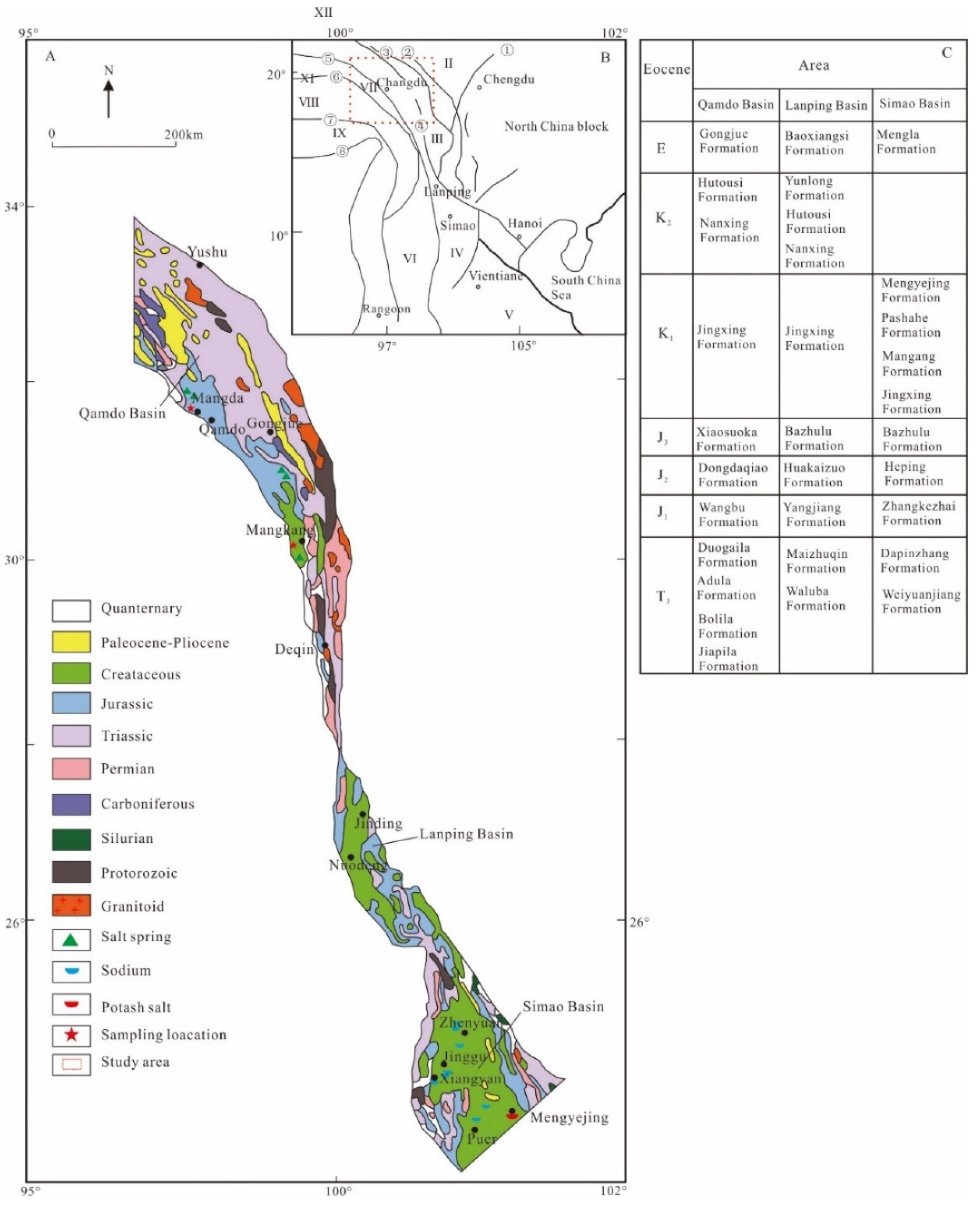
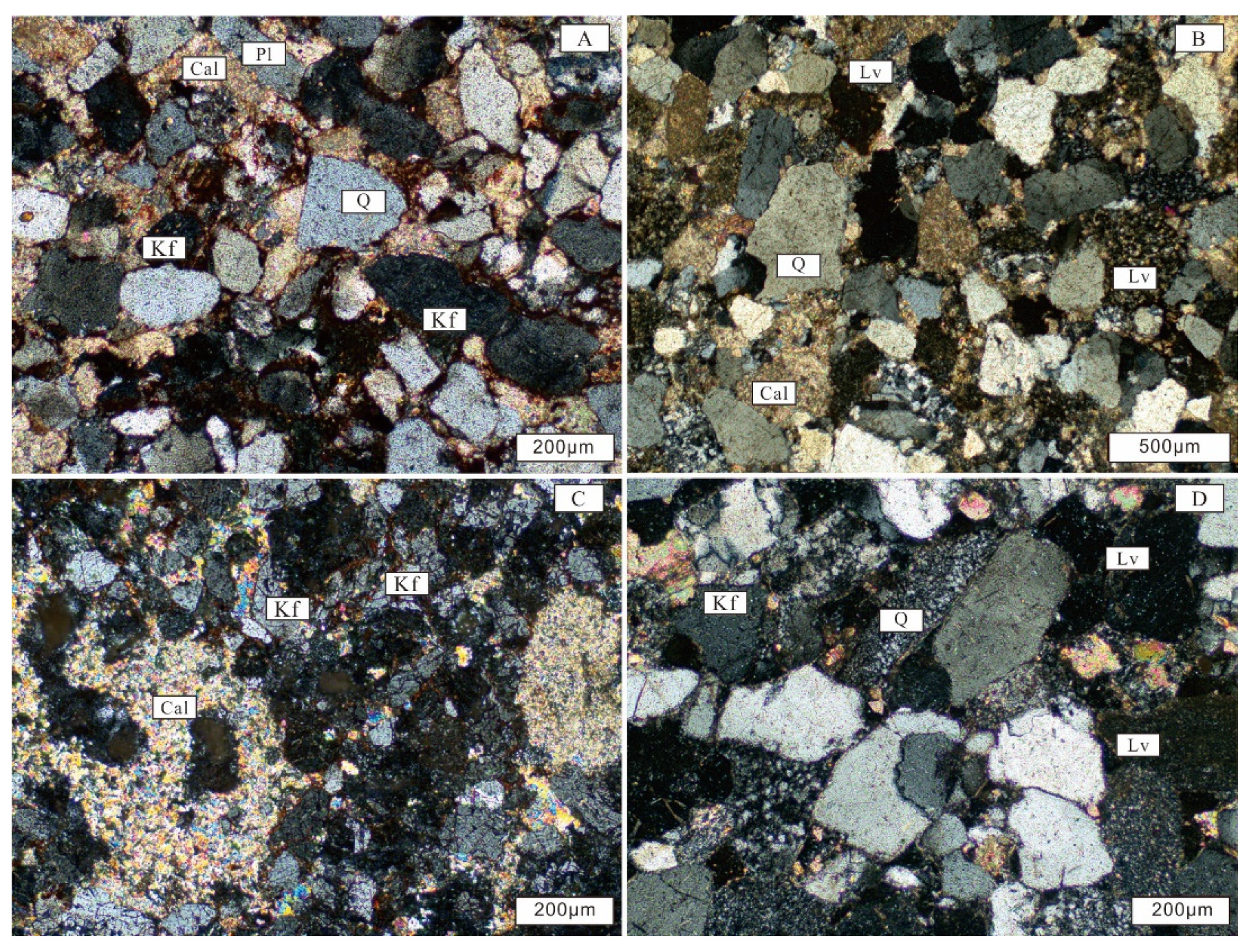
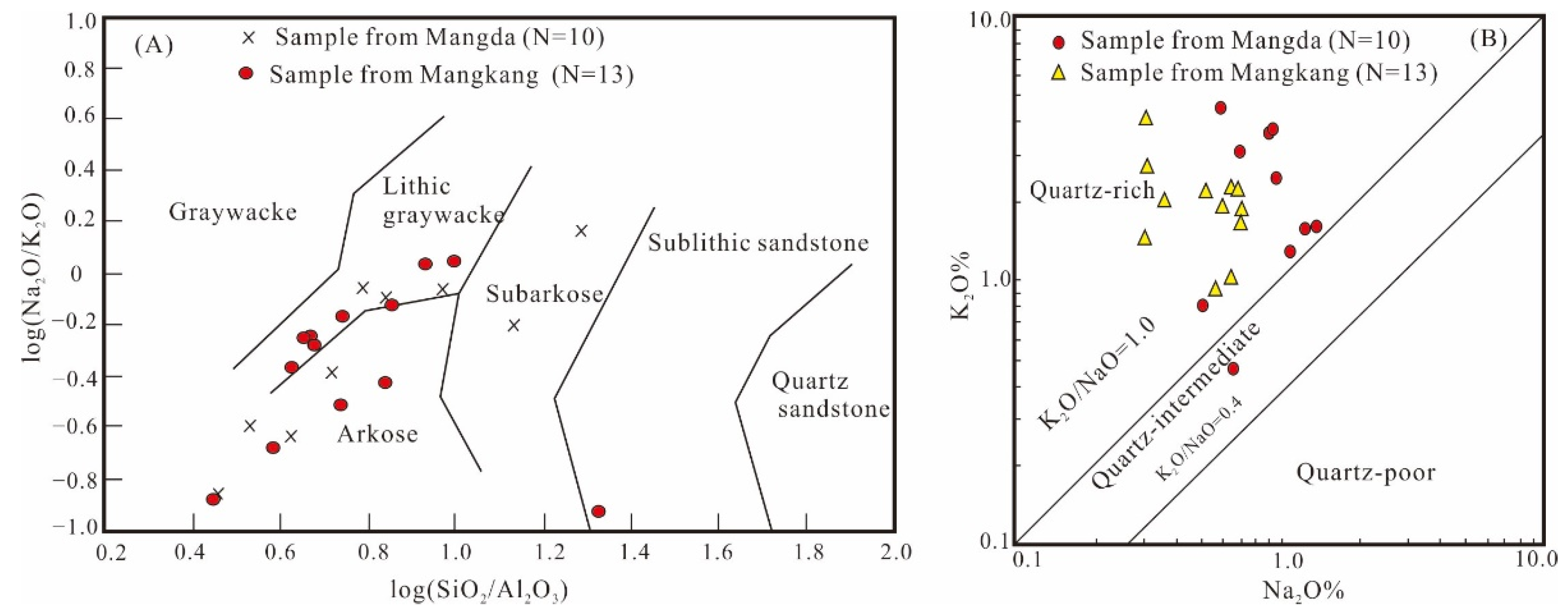
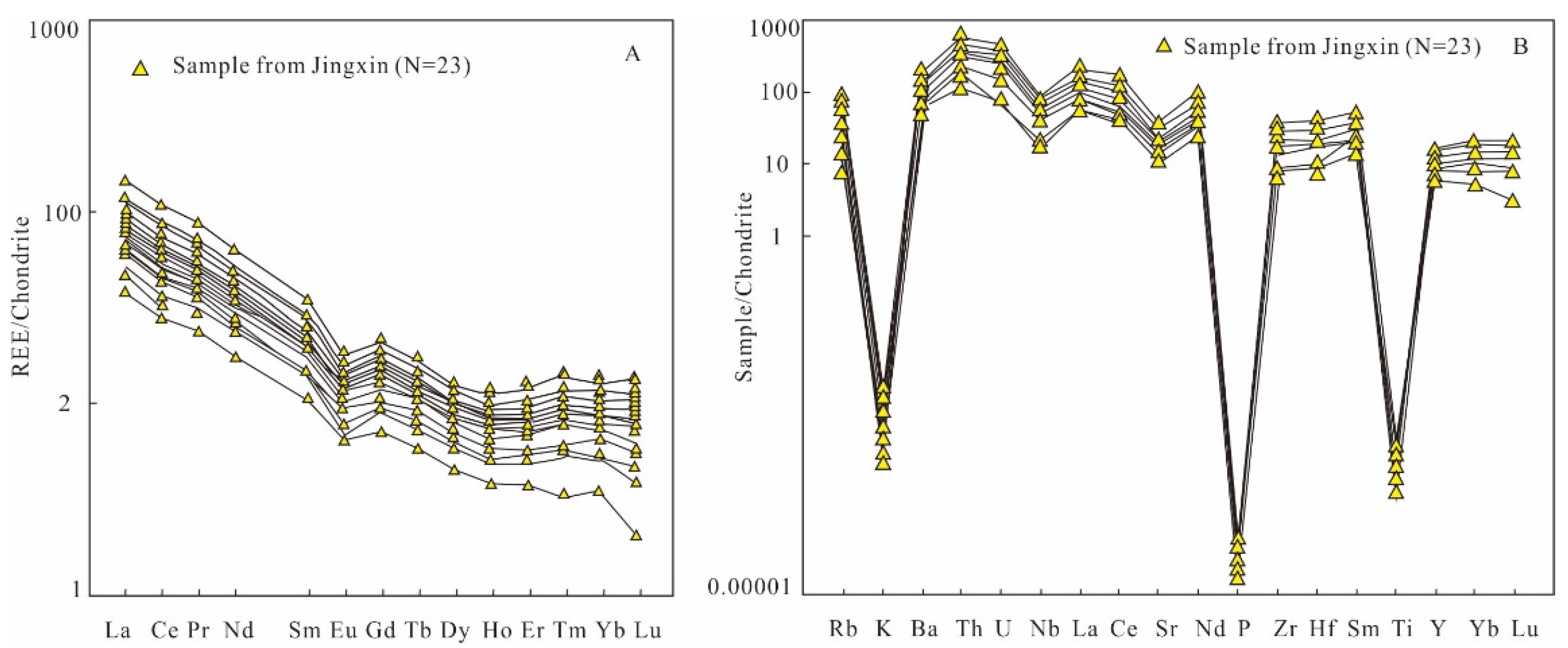
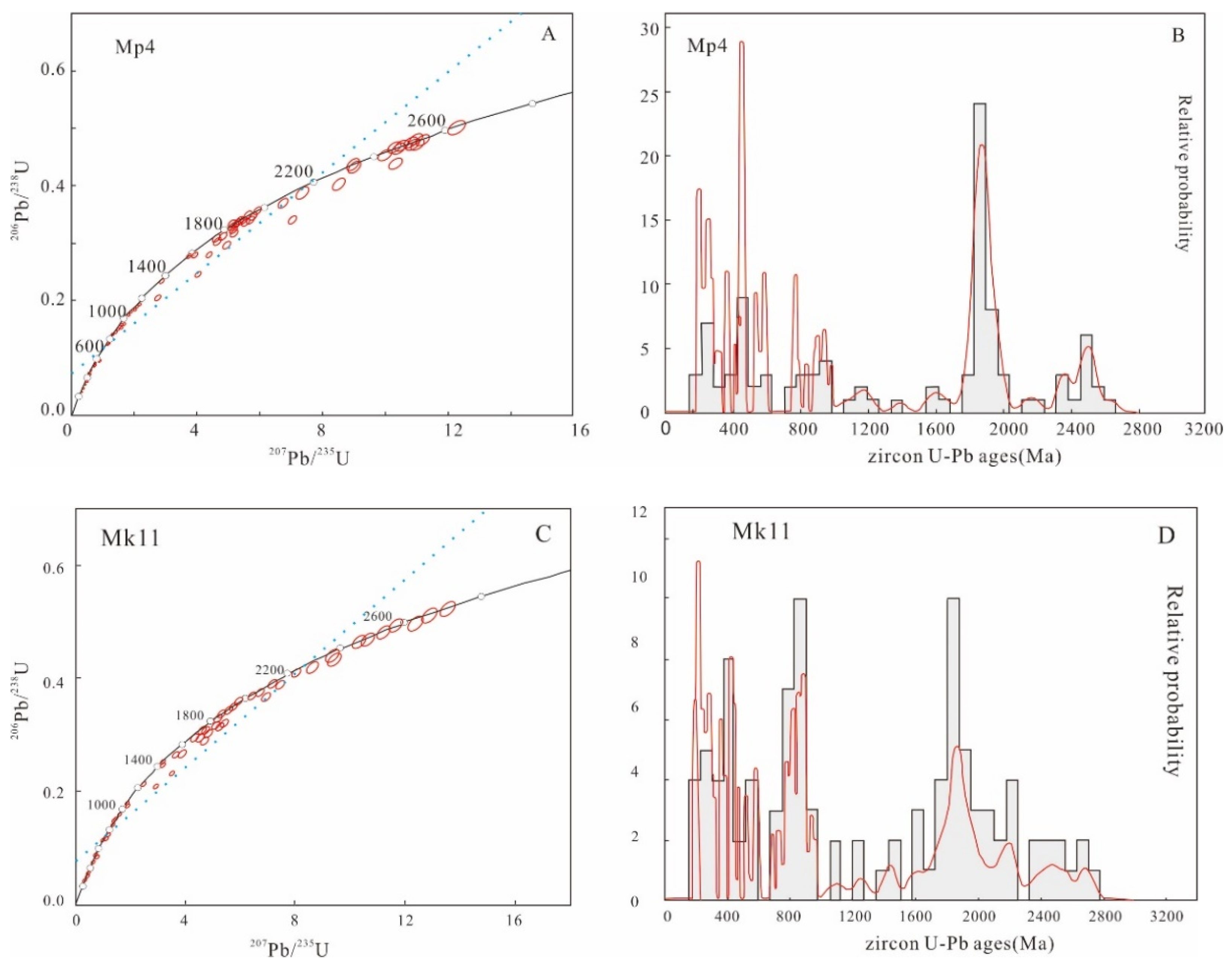
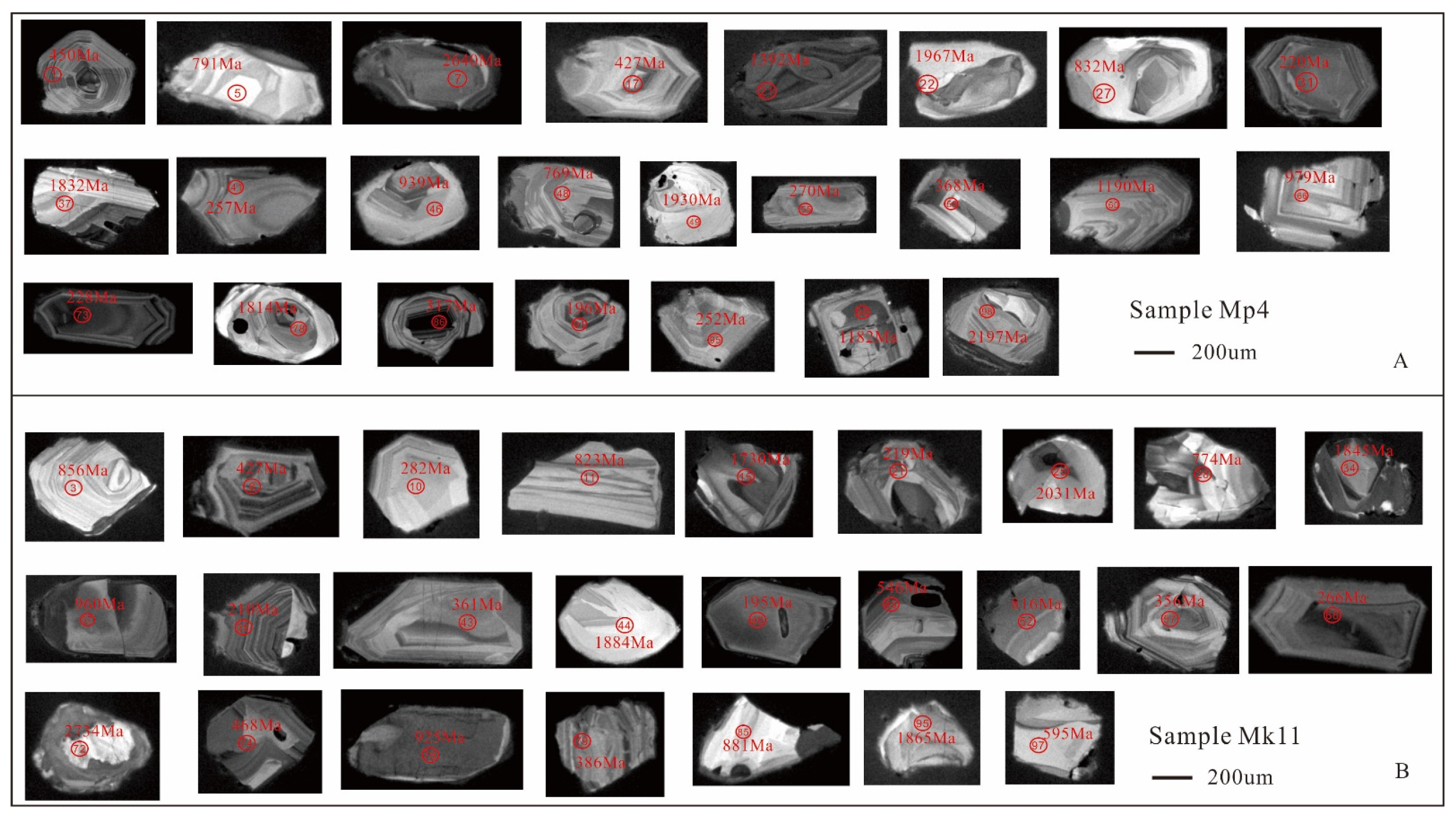
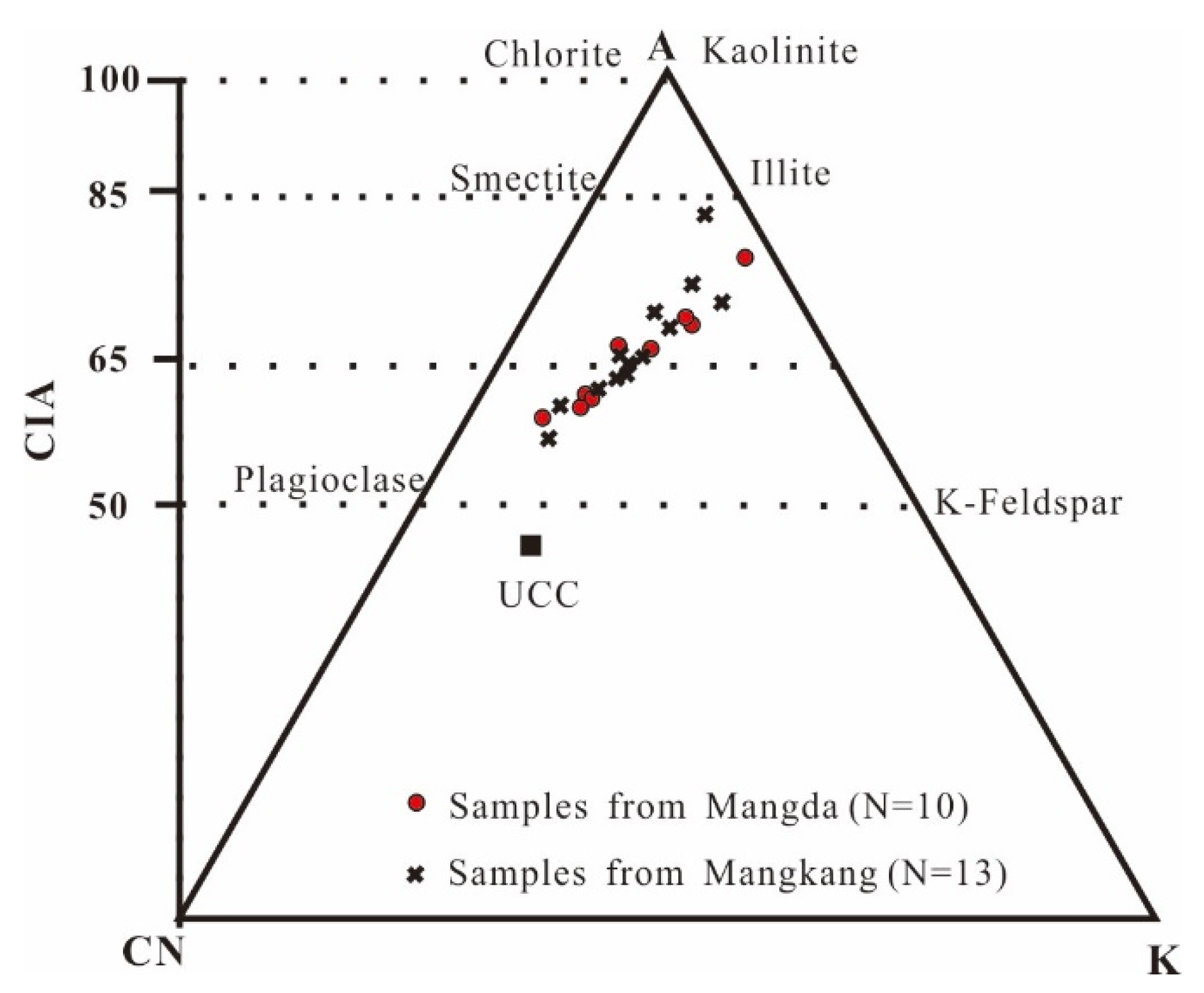

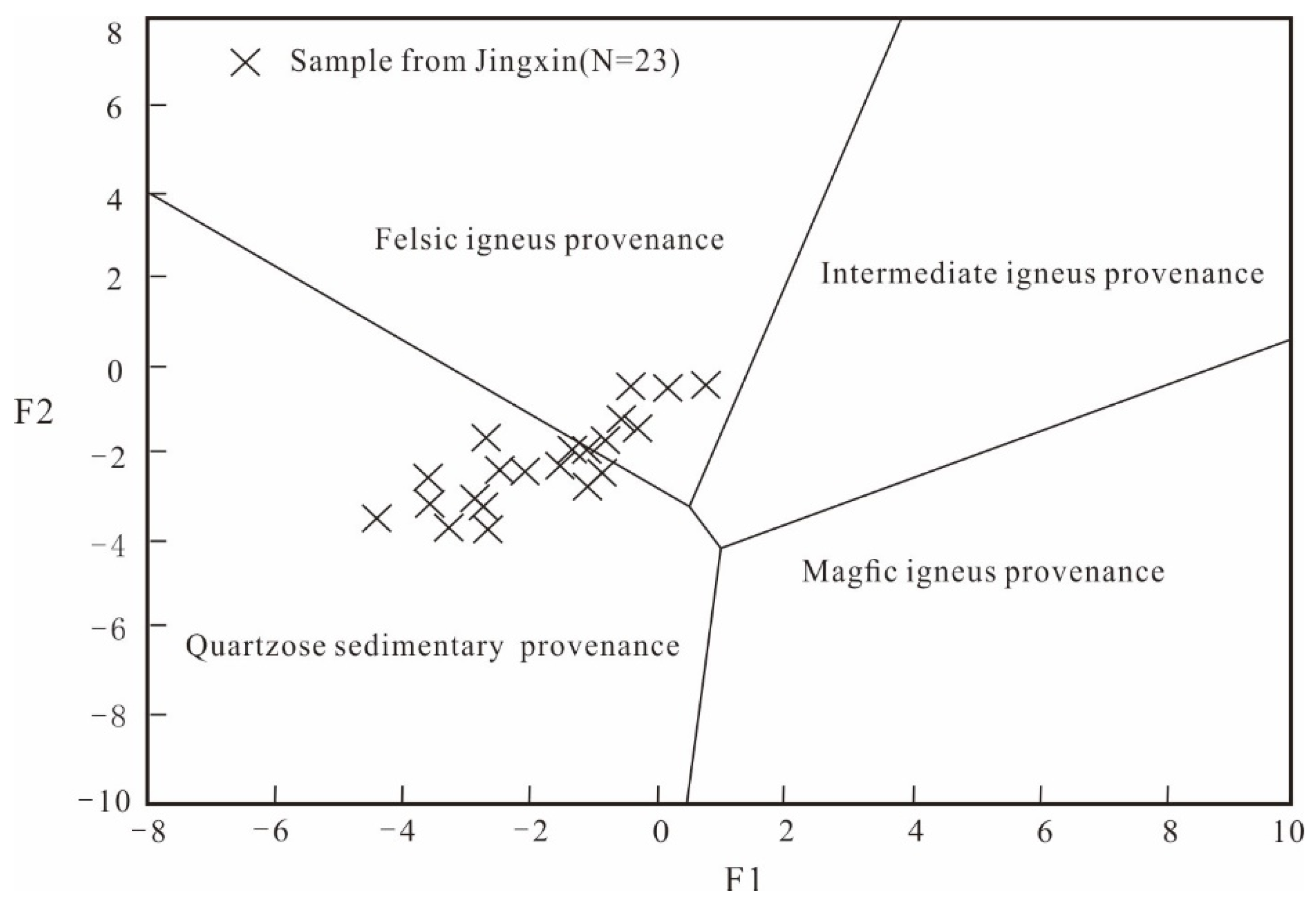
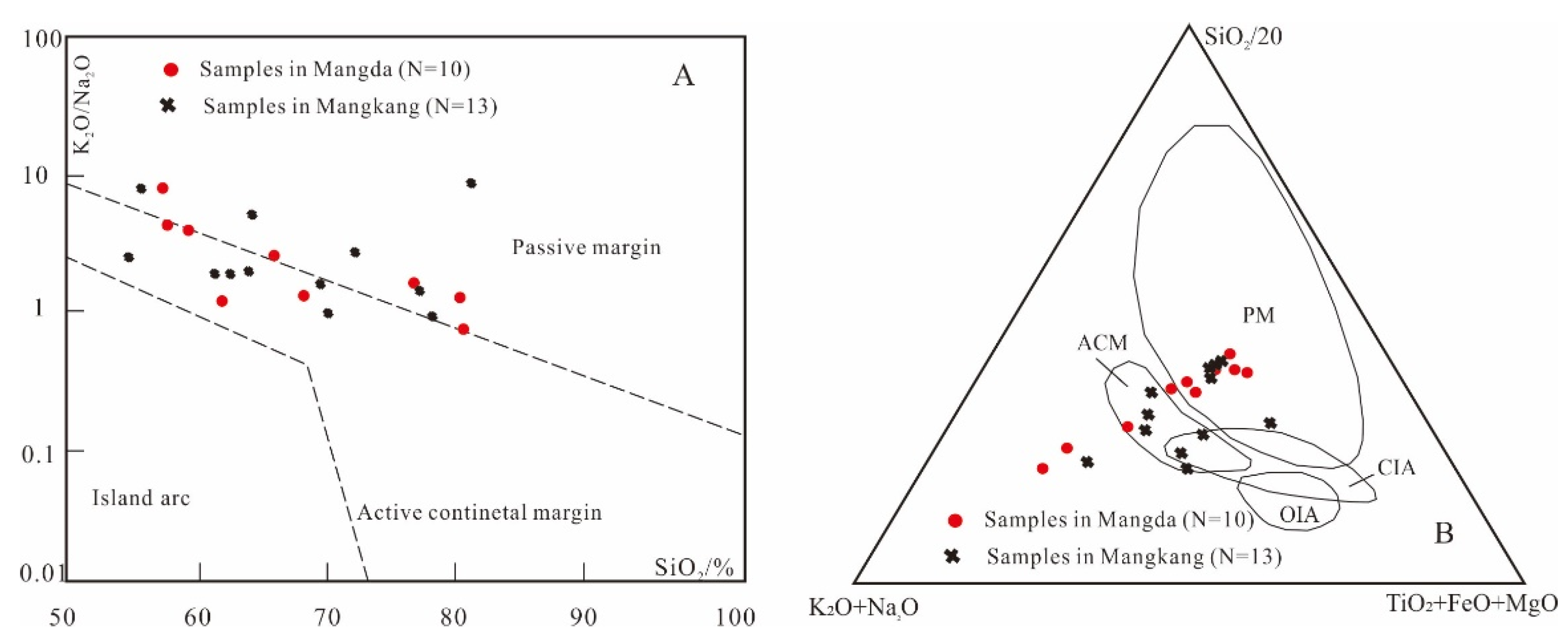
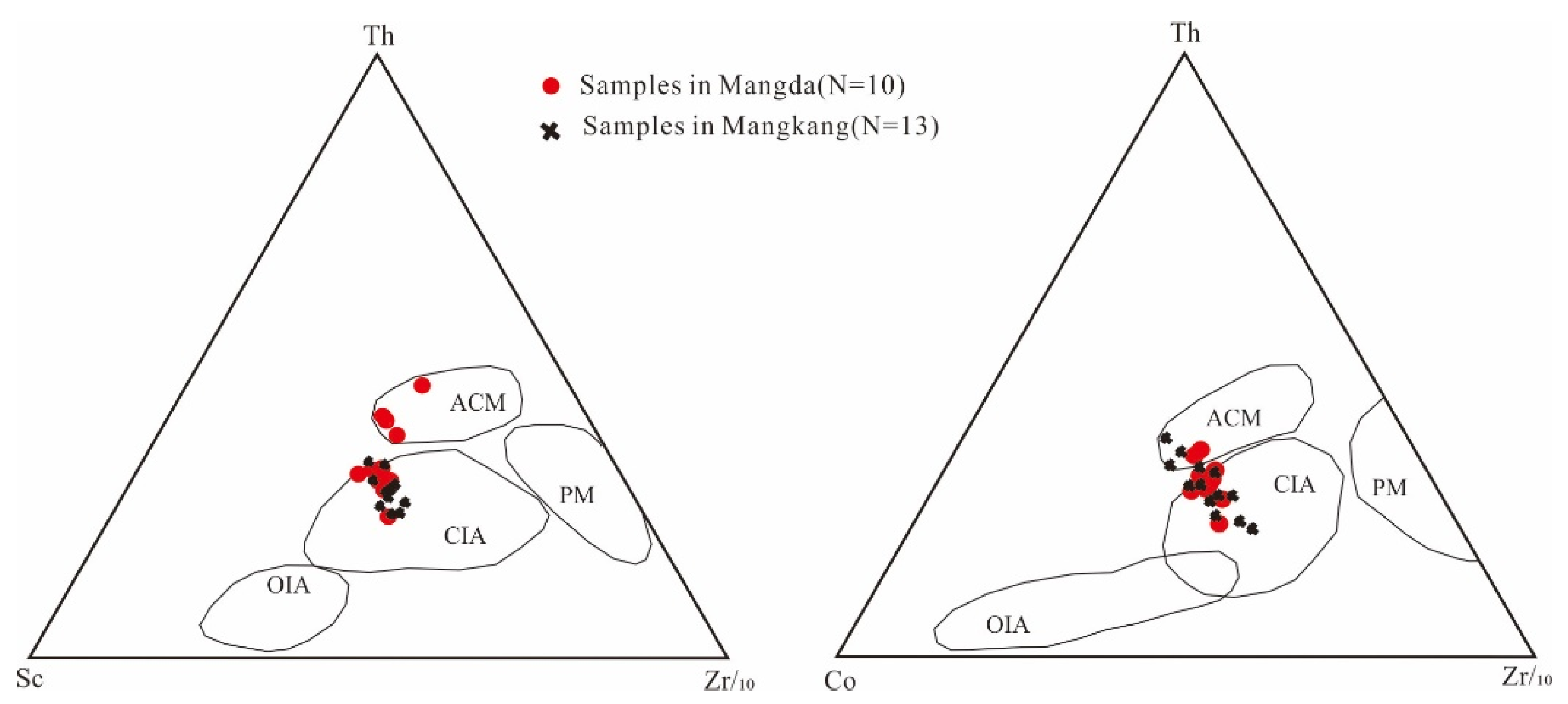


Publisher’s Note: MDPI stays neutral with regard to jurisdictional claims in published maps and institutional affiliations. |
© 2021 by the authors. Licensee MDPI, Basel, Switzerland. This article is an open access article distributed under the terms and conditions of the Creative Commons Attribution (CC BY) license (https://creativecommons.org/licenses/by/4.0/).
Share and Cite
Han, W.; Ma, H.; Fang, W.; Cheng, H.; Li, Y.; Li, B.; Miao, W.; Hai, Q. U-Pb Detrital Zircon Ages and Geochemical Features of the Jingxing Formation, (Qamdo Basin, Tibet: Implications): Inferences for the Metallogenic Model of the East Tethys Evaporite. Minerals 2021, 11, 745. https://doi.org/10.3390/min11070745
Han W, Ma H, Fang W, Cheng H, Li Y, Li B, Miao W, Hai Q. U-Pb Detrital Zircon Ages and Geochemical Features of the Jingxing Formation, (Qamdo Basin, Tibet: Implications): Inferences for the Metallogenic Model of the East Tethys Evaporite. Minerals. 2021; 11(7):745. https://doi.org/10.3390/min11070745
Chicago/Turabian StyleHan, Wenhua, Haizhou Ma, Weixuan Fang, Huaide Cheng, Yongshou Li, Binkai Li, Weiliang Miao, and Qinyu Hai. 2021. "U-Pb Detrital Zircon Ages and Geochemical Features of the Jingxing Formation, (Qamdo Basin, Tibet: Implications): Inferences for the Metallogenic Model of the East Tethys Evaporite" Minerals 11, no. 7: 745. https://doi.org/10.3390/min11070745
APA StyleHan, W., Ma, H., Fang, W., Cheng, H., Li, Y., Li, B., Miao, W., & Hai, Q. (2021). U-Pb Detrital Zircon Ages and Geochemical Features of the Jingxing Formation, (Qamdo Basin, Tibet: Implications): Inferences for the Metallogenic Model of the East Tethys Evaporite. Minerals, 11(7), 745. https://doi.org/10.3390/min11070745




